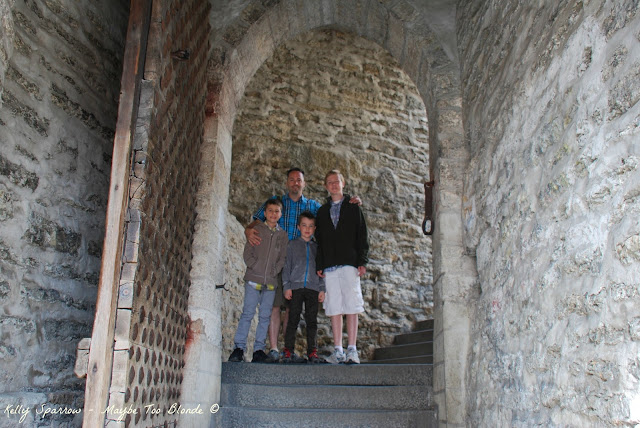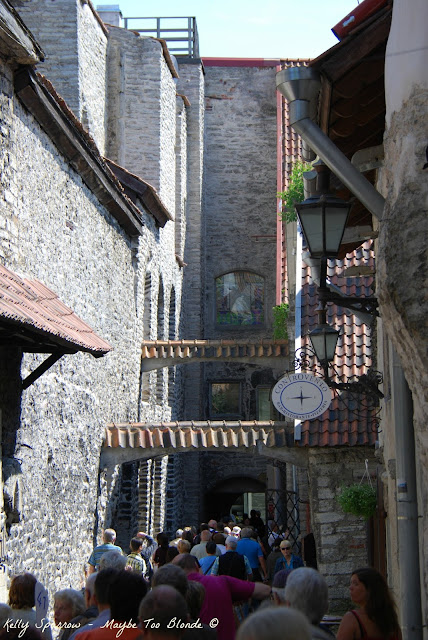Want to read about where we were before in Stockholm, Sweden? Click here for part 1 and here for part 2.
Let's first start with a geography lesson. Can anyone here locate Estonia on a map?
There. Does that help?
Don't feel bad if you didn't know where it was. I read that something like 50% of adults in the United States can't name or locate countries that used to be part of the USSR. That's right, Estonia used to be part of the USSR. The Big Red.
Our time in Estonia was spent in the medieval style old town center of Tallinn. Tallinn is the capital of Estonia. The ancient part of the city is surrounded by the intact walls that fortified the city.
As we walked down this jaunty little street, I kept saying to myself 'I am in the former USSR. I am in the USSR!' Matt and I kept looking at each other with a some disbelief. As children who grew up in the 70's and 80's, we never could have imagined coming to this place. We grew up in a time when the Cold War was hot and was first and foremost on everybody's mind. I tried explaining to my kids how special this really was and how their dad and I watched the fall of communism and the break up of the USSR with disbelief. How the world cheered and America considered themselves the victors of the long stare down and nuclear build up between America and the USSR. I don't think they were as impressed with being here as we were.
After explaining the difference between being a communist and a columnist to Andre, we got on our way.
This a famous pub where you can snag a drink or a quick meal. The name Hell Hunt means "Gentle Wolf" in Estonian. That would have to be one really gentle wolf to let a naked lady ride on his back. They speak Estonian here. A language closely related to not Russian, but Finnish.
Tallinn is built on a hill, much like many old cities all over Europe, and it has narrow winding streets that climb between terraced buildings.
This is the Raekoja plats, or old town square of Tallinn. They had a large market set up selling every kind of souvenir you could think of.
Here are my "main men" in one of the small alley ways that snake around Tallinn.
This is the Alexander Nevsky Cathedral. It is an orthodox cathedral built in 1894. Back home in the States, we would have remarked how great this building looks for being over 100 years old. Here in Europe at 100 years old, it seems practically brand new to some of the cathedrals we've seen. Alexander Nevsky is a saint in the Russian Orthodox Church. He was born in 1220.
This is the inside of an Evangelical Lutheran church down the street from the cathedral. Inside hung all these elaborate family crests of families that have lived in the area for hundreds of years.
As we walked around, the city became more and more crowded. When we got to the top of the hill we looked out at the bay and realized that five cruise ships were docked in Tallinn. If each cruise ship holds 3,000 people (conservative estimate) and there were five, that means that 15,000 people were wandering around this small, medieval town. And let me tell you, this town was not intended to hold 15,000 tourists at one time. So we sought out little corners like this above where we could hide out and escape the tourists.
Here is a picture of my new, ultimate pet peeve. The large tour group. They are usually led by someone holding a sign so that the tourists can easily follow the leader. The people in the tour group are wearing stickers on their shirts so they are easily identifiable to other tour groups. It reminds me of a preschool field trip to the zoo. Why do I hate large tour groups? Because they clog sights, the move en masse. Every time we saw a tour group, we turned the other way.
Which was okay because we saw little places like this.
Here is a panoramic view of Tallinn. While walking around the old town, I happened along a time line of Estonia that was in laid in the sidewalk in bronze. It mentioned things like the ice age ended in Estonia, first settlements in Estonia, Tallinn first placed on a map and on and on. Estonia had a bright and proud past it would seem. I then came across the years that Estonia was part of the USSR (1940-1991). Other time periods were given lengthy descriptions. The time Estonia was part of the USSR had a one word description in black, not bronze. The Occupation. I guess that pretty much sums up how the Estonians felt about being annexed against their will into the USSR.
Even though the old town was well maintained and clean, Estonia's communist past wasn't far away. Up on the hill we were able to see old abandoned Soviet era factories dotting the landscape.
Estonia has worked hard to leave behind its past and to make its future brighter. Two years ago they left their currency behind and joined the Euro Zone. But even with them joining the Euro and the fact that Estonia has the best economy of any former USSR country, it seems that this whole "Baltic Tourism" thing has kind of blind sided them. What do I mean? Here is what I observed and after all the traveling we have done this year, I feel I can give a pretty good synopsis.
1- There were souvenir shops everywhere. Every little nook and cranny was crowded with souvenir shops selling amber jewelry, fur hats, wool sweaters, wool hats, wool scarves, linen aprons, pottery, and antlers. They were selling anything and everything that has to do with the Baltic region of Europe.
2- There were only a handful of restaurants set up around the old town square and market. These facts made it so everyone (all 15,000 of us) ended up congregating in one area slightly smaller than a football field.
3- Even with all the souvenir shops, there was no where to buy a drink, or treat, or gelato, or crape anywhere in town but the above mentioned few restaurants.
4- There was one public bathroom in the whole town and that was up on the top of the hill. This made it so people had to find little hidey-holes to pee in every chance they got.
Baltic cruises are the "new cool thing" to do I read and Tallinn is a new stop on these cruises. While Tallinn does deserve your time and with Estonia's rich history it is a great stop, they just don't have the "tourism structure" to support the large groups of tourists they are getting. I think that when Tallinn started getting a lot of tourists everyone wanted to cash in. They looked for the quickest and easiest way to make a quick buck, or Euro. Selling souvenirs that won't spoil, that can be kept in the back of your house is the easiest way to make that quick Euro. Selling food or services takes much more time, overhead, and preparation so they just aren't doing it. While we still had time left to tour Tallinn, we really were just done and we headed back to our floating home, the Costa Fortuna, early.
As we walked back we kept remarking how beautiful Tallinn was, but how unpleasant the crowds were. Andre kept saying that we will just have to go back.
One bright point was that as we walked back to the ship, we passed a convenience store and we stopped in for some soda. Coke has this new thing in Europe where you can send your name into the company and they will print bottles with your name on it. Here is a sampling of the names that were on our bottles. I don't know if these are real. Is there really someone in Estonia walking around with the name Äss? Or Sõber? My kids had fun rearranging these to make funny sayings. Okay, it wasn't my kids. It was Matt. Matt had fun rearranging these to make funny sayings.
Next stop on our cruise - RUSSIA!
PS What did you think of Estonia? Is it somewhere you would like to go?




















